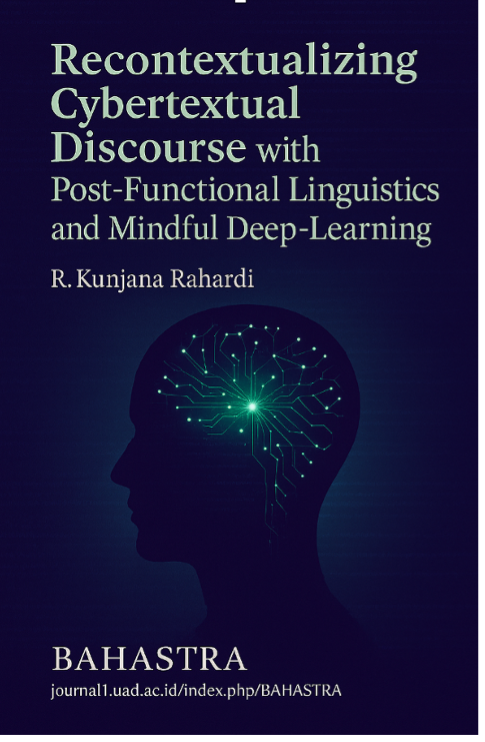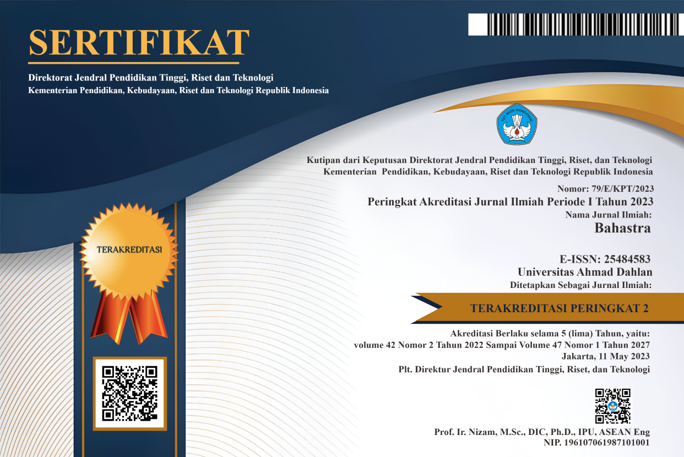Recontextualizing cybertextual discourse with post-functional linguistics and mindful deep-learning
DOI:
https://doi.org/10.26555/bs.v45i2.1695Keywords:
Linguistics Paradigm Post-Functional , Linguistics Cybertextual Context , Mindful LearningAbstract
This study explores the conceptualization of linguistic context as cybertextual, a multimodal and digitally mediated construct within the framework of post-functional linguistics. It argues that digital communication extends linguistic boundaries, integrating visual, gestural, aural, spatial, and textual modes in meaning-making. Anchored in mindful deep learning, mindfulness is viewed not only as cognitive awareness but as a pedagogical stance that nurtures attentiveness, emotional regulation, and reflective engagement with multimodal semiotic resources. The study aims to (1) classify diverse forms of cybertextual context and (2) interpret their functional identities through mindful learning. Using a qualitative descriptive approach, it analyzes authentic data from Instagram to examine meaning construction through semiotic layering. Employing extralinguistic equivalence analysis, the research identifies five interrelated modalities—visual, gestural, aural, spatial, and linguistic—each contributing distinctively to interactional meaning. The integration of mindful deep learning within this model reveals how learners can cultivate semiotic sensitivity, interpretive accuracy, and empathetic communication in digital environments. The study advances post-functional linguistic theory and provides pedagogical insights for fostering critical and ethical language awareness in multimodal, digitally enriched learning settings.
References
Armstrong, E., & Ferguson, A. (2010). Language, meaning, context, and functional communication. Aphasiology, 24(4), 480-496. https://doi.org/10.1080/02687030902775157
Bezemer, J., & Kress, G. (2016). Multimodality, learning, and communication: A social semiotic frame. https://doi.org/10.4324/9781315687537
Burke, N. J., Joseph, G., Pasick, R. J., & Barker, J. C. (2009). Theorizing social context: Rethinking behavioral theory. Health Education and Behavior, 36(5). https://doi.org/10.1177/1090198109335338
Depraetere, I. (2019). Meaning in context and contextual meaning: A perspective on the semantics-pragmatics interface applied to modal verbs. Anglophonia, 28. https://doi.org/10.4000/anglophonia.2453
Duffy, M. K., Scott, K. L., Shaw, J. D., Tepper, B. J., & Aquino, K. (2012). A social context model of envy and social undermining. Academy of Management Journal, 55(3). https://doi.org/10.5465/amj.2009.0804
Forceville, C. J. (2010). The routledge handbook of multimodal analysis. Journal of Pragmatics, 42(9), 2604-2608. https://doi.org/10.1016/j.pragma.2010.03.003
Haugh, M. (2006). Emic perspectives on the positive-negative politeness distinction. Culture, Language and Representation, 3(October).
___________. (2022). (Online) public denunciation, public incivilities and offence. Language and Communication, 87, 44-59. https://doi.org/10.1016/j.langcom.2022.07.002
Haugh, M., & Sinkeviciute, V. (2021). The pragmatics of initial interactions: Cross-cultural and intercultural perspectives. Journal of Pragmatics, 185, 35-39. https://doi.org/10.1016/j.pragma.2021.09.004
Hirschberg, J. (2002). The pragmatics of intonational meaning. Speech Prosody 2002. https://doi.org/10.21437/SpeechProsody.2002-9
House, J. (2006). Constructing a context with intonation. Journal of Pragmatics, 38(10), 1542-1558. https://doi.org/10.1016/j.pragma.2005.07.005
Ibrahim, A., & Maniam, M. (2020). A review article of the pragmatics-based-curriculum in EFL context: Focus on the curriculum in Iraq. Budapest International Research and Critics in Linguistics and Education (BirLE) Journal, 3(2), 1065-1073. https://doi.org/10.33258/birle.v3i2.1035
Ishihara, N. (2010). Instructional pragmatics: Bridging teaching, research, and teacher education. Linguistics and Language Compass. https://doi.org/10.1111/j.1749-818X.2010.00242.x
Johnson, D. W., & Johnson, R. T. (2014). Cooperative learning in 21st century. Anales De Psicología, 30(3), 841-851. https://doi.org/10.6018/analesps.30.3.201241
Kelly, S. D., Barr, D. J., Church, R. B., & Lynch, K. (1999). Offering a hand to pragmatic understanding: The role of speech and gesture in comprehension and memory. Journal of Memory and Language, 40(4), 577-592. https://doi.org/10.1006/jmla.1999.2634
Kress, G. (2009). Multimodality: A social semiotic approach to contemporary communication. https://doi.org/10.4324/9780203970034
Li, H., & Wang, M. (2016). Culpeper, Jonathan & Haugh, Michael: Pragmatics and the English language. Intercultural Pragmatics, 13(4). https://doi.org/10.1515/ip-2016-0026
Mahsun. (2007). Metode penelitian bahasa: Tahapan strategi, metode, dan tekniknya (Edisi Revisi). Raja Grafindo Persada.
Peñarroja, M. R. (2020). Corpus pragmatics and multimodality: Compiling an ad-hoc multimodal corpus for EFL pragmatics teaching. International Journal of Instruction, 14(1). https://doi.org/10.29333/IJI.2021.14155A
Pramudyani, A. V. R. (2018). Kurikulum holistik integratif berbasis permainan tradisional pada PAUD di Yogyakarta integrative holistic curriculum based on traditional games at kindergarten in Yogyakarta. Jurnal Penelitian Ilmu Pendidikan, 10(2). https://doi.org/10.21831/jpipfip.v10i2.17910
Rahardi, R. K. (2020a). Konteks eksternal virtual dalam pragmatik siber virtual external contexts in cyberpragmatics. Jurnal Pendidikan Bahasa dan Sastra Indonesia Metalingua, 15(2). https://doi.org/10.26499/loa.v15i2.2347
___________. (2020b). Triadic functions of situational context of hate speeches: A cyberpragmatic perspective. Metalingua.
___________. (2022). Triadicities of Indonesian phatic functions. Theory and Practice in Language Studies, 12(12), 2641–2650. https://doi.org/10.17507/tpls.1212.22
___________. (2023). Social–societal context element changes in cyberpragmatics perspective. Theory and Practice in Language Studies, 13(11), 2771–2779. https://doi.org/10.17507/tpls.1311.06
Rahardi, R. K., & Firdaus, W. (2023). Expert judgements of integrated cyberpragmatics learning model with socio-semiotics multimodality-based cybertext contexts. Aksara, 35(2). https://doi.org/10.29255/aksara.v35i2.4160.211--227
Richards, J. C. (2013). Curriculum approaches in language teaching: Forward, central, and backward design. RELC Journal, 44(1). https://doi.org/10.1177/0033688212473293
Richards, J. C., & Rodgers, T. (2006). Method: Approach, design, and procedure. TESOL Quarterly. https://doi.org/10.2307/3586789
Schandorf, M. (2013). Mediated gesture: Paralinguistic communication and phatic text. Convergence, 19(3). https://doi.org/10.1177/1354856512439501
Serafini, F. (2015). Multimodal literacy: From theories to practices. Language Arts, 92(6). https://doi.org/10.58680/la201527389
Shin, Y. S., Masís-Obando, R., Keshavarzian, N., Dáve, R., & Norman, K. A. (2021). Context-dependent memory effects in two immersive virtual reality environments: On mars and underwater. Psychonomic Bulletin and Review, 28(2). https://doi.org/10.3758/s13423-020-01835-3
Smith, J., Bekker, H., & Cheater, F. (2011). Theoretical versus pragmatic design in qualitative research. Nurse Researcher. https://doi.org/10.7748/nr2011.01.18.2.39.c8283
Sudaryanto. (2015). Metode dan aneka teknik analisis bahasa: Pengantar penelitian wahana kebudayaan secara linguistis (1st ed.). Sanata Dharma University Press.
Wälti, M. J., Woolley, D. G., & Wenderoth, N. (2019). Reinstating verbal memories with virtual contexts: Myth or reality? PLoS ONE, 14(3). https://doi.org/10.1371/journal.pone.0214540
Yarossi, M., Mangalam, M., Naufel, S., & Tunik, E. (2021). Virtual reality as a context for adaptation. Frontiers in Virtual Reality, 2. https://doi.org/10.3389/frvir.2021.733076

Downloads
Published
Issue
Section
License
Copyright (c) 2025 R. Kunjana Rahardi

This work is licensed under a Creative Commons Attribution-ShareAlike 4.0 International License.

1.jpg)






